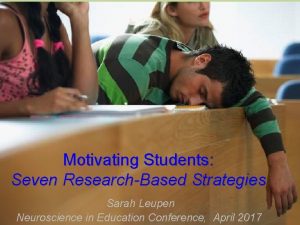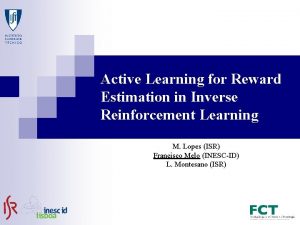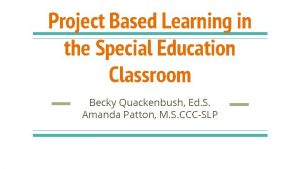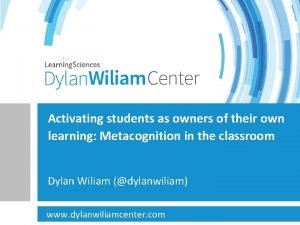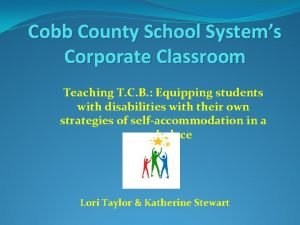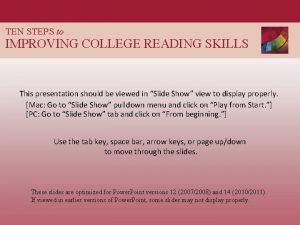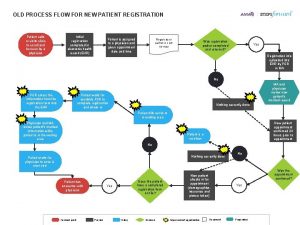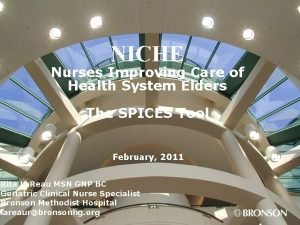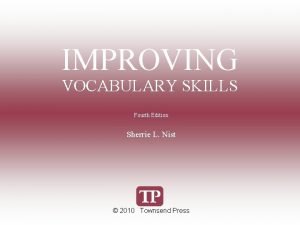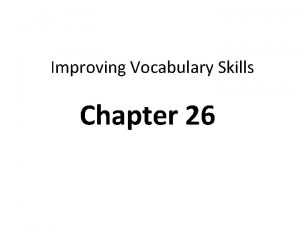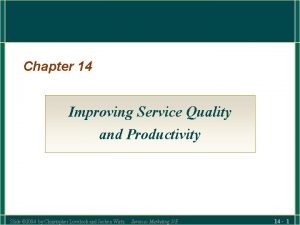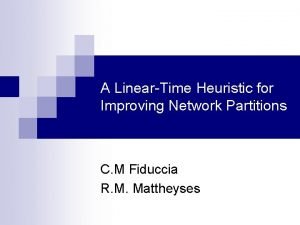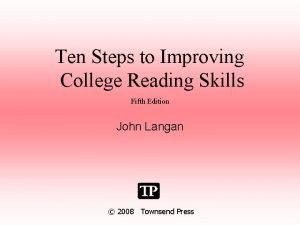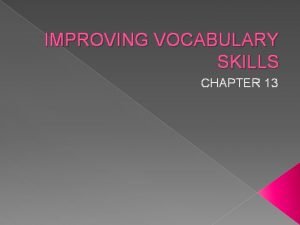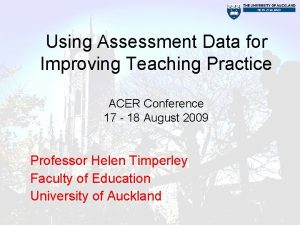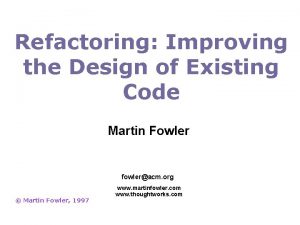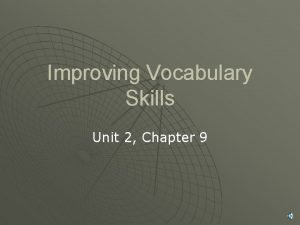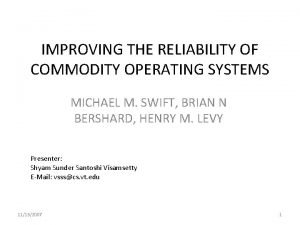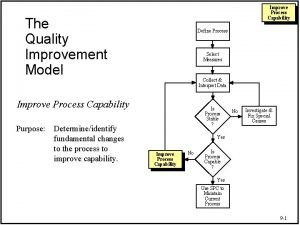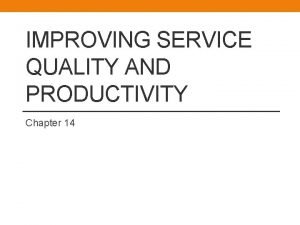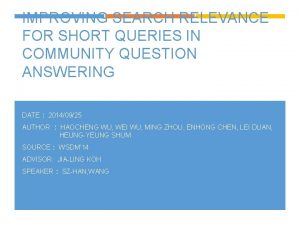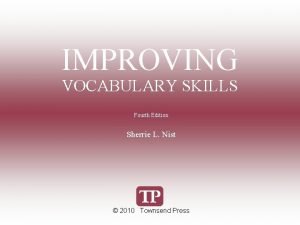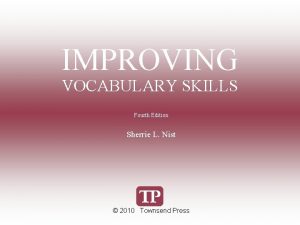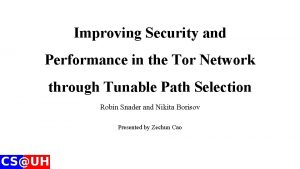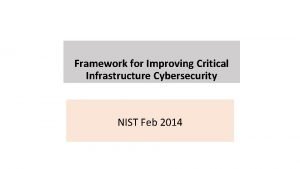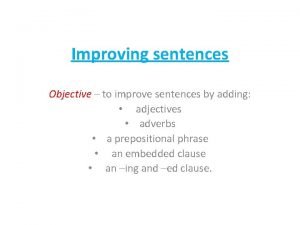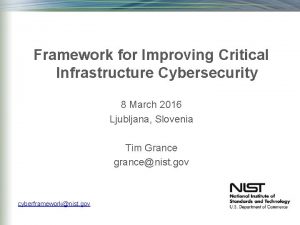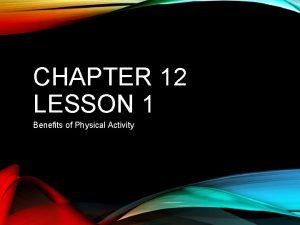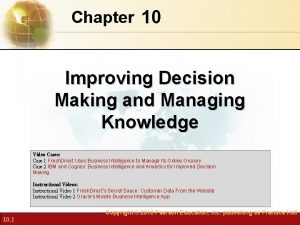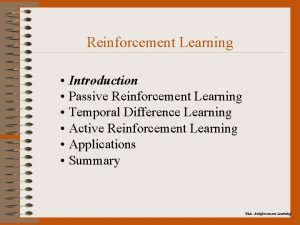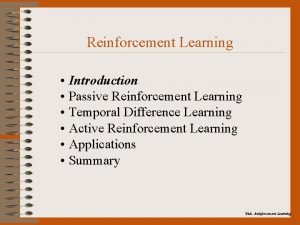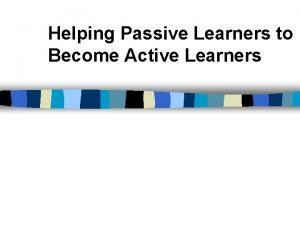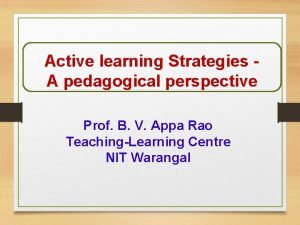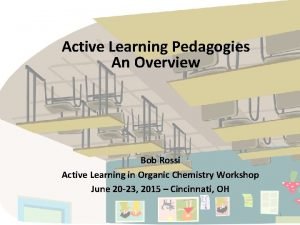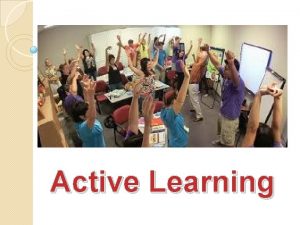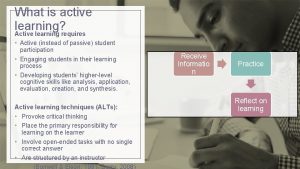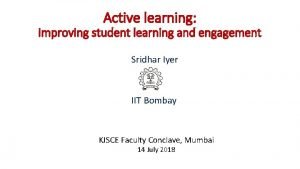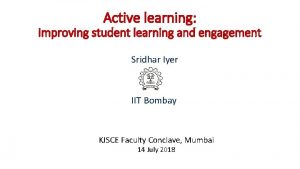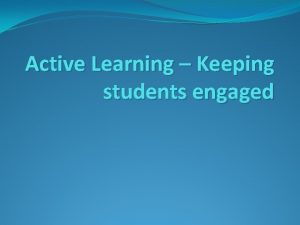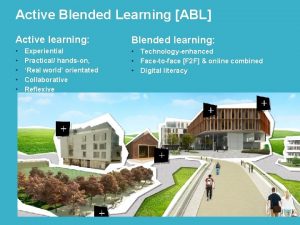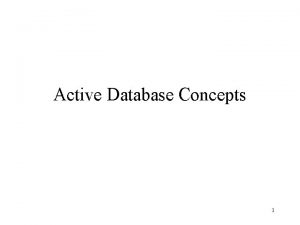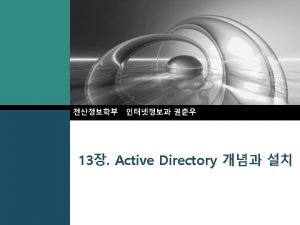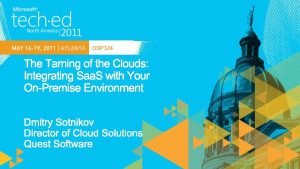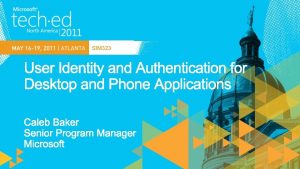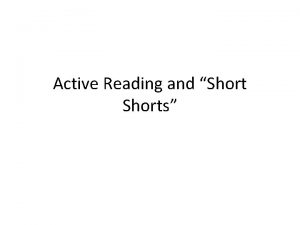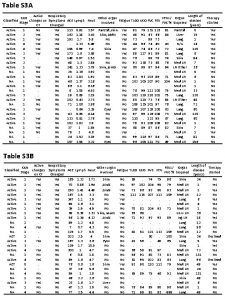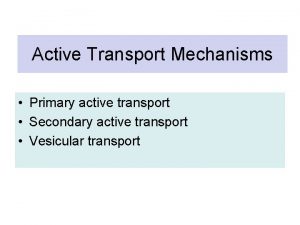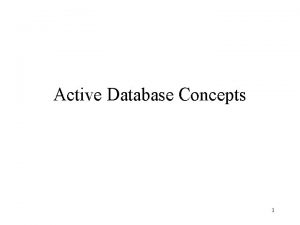Active Learning In the Classroom Improving Students Engagement

























































![Example 3: What does this code do? main () { int vn=9, va[vn]; for Example 3: What does this code do? main () { int vn=9, va[vn]; for](https://slidetodoc.com/presentation_image/2fab80b2760e9535aad1cda070ee0adb/image-58.jpg)

























































- Slides: 115

Active Learning In the Classroom Improving Students' Engagement and Learning in Large Classes Sridhar Iyer sri@iitb. ac. in IDP in Educational Technology, & Dept of Computer Science and Engg. , Indian Institute of Technology Bombay SUTD, Singapore, 20 June 2016 This presentation is released under Creative Commons-Attribution 4. 0 License. SUTD You are free to use, distribute and modify it , including for commercial purposes, IIT Bombay provided you acknowledge the source. 1

Interdisciplinary programme in Educational Technology • Started April 2010. • Ph. D. program – Research in: – Technology enhanced learning environments for the development of pandomain cognitive abilities. Ex: engineering design, system-thinking, problem posing, data visualization, algorithmic thinking, spatial abilities. – Teacher use of educational technologies and strategies. • Outreach: – Workshops, Consultancy, Continuing Education Program. – Pedagogies for effective use of educational technologies. • • Workshops of varying durations - 3 days to 3 weeks to 3 months. Face-to-face as well as distance education modes. 4000+ teachers attended the workshop in Jan 2015, via remote classrooms. 5500+ teachers attended MOOC on IITBombay. X during Jan-Mar 2016. – This talk is an overview of some topics from these workshops. SUTD IIT Bombay 2

How engaged are your students? • Consider a large class. (In IITB - 111/ 112, N ~ 150; CS 101, N~250 per section) • Imagine a 90 -minute class in a large auditorium with fixed seats. Think (Individually): Percentage of students engaged • Predict the percentage of students who may be showing “engaged” behaviour (with the content of the lecture), at various instants of time. • Draw a graph of engagement versus time. [~1 min] % e t (Time instant of lecture) SUTD IIT Bombay 3

How engaged are your students? • Consider a large class. • Imagine a 90 -minute class in a large auditorium with fixed seats. Think (Individually): • Predict the percentage of students who may be showing “engaged” behaviour (with the content of the lecture), at various instants of time. • Draw a graph of engagement versus time. [~1 min] Pair (with your neighbour): Percentage of students engaged • Examine each other’s graphs. [~1 min] • Together, come up with two techniques that could be used to convert your graph into something that looks like the figure shown. [~2 min] SUTD IIT Bombay 80% %e t (Time instant of lecture) 4

How engaged are your students? • Consider a large class. Imagine a 90 -minute class in a large auditorium with fixed seats. Think (Individually): • Predict the percentage of students who may be showing “engaged” behaviour (with the content of the lecture), at various instants of time. • Draw a graph of engagement versus time. [~1 min] Pair (with your neighbour): • Examine each other’s graphs. [~1 min] • Together, come up with two techniques to convert your graph into something that looks like the figure. [~3 min] %e 80% Share (entire audience): t (Time instant of lecture • Share pros and cons of some techniques. [~2 min each] • Identify top three techniques that are likely to “succeed”. [~3 min] SUTD IIT Bombay 5

Can we engage students by … • Telling jokes? - only during the joke • Historical anecdotes? - interesting, useful - but can only be done occasionally • Giving real life context? - necessary, good motivation, but again, 1 -2 times per topic • Showing demos, videos - useful but not sufficient • Asking – “do you have any doubts? ” - necessary, might results in ‘blips’ in engagement curve • Asking a question related to the topic? - necessary, might results in ‘blips’ in engagement curve SUTD IIT Bombay 6

How to maintain students’ engagement in the content? Active learning. SUTD IIT Bombay 7

My lectures are plenty interactive! • I often pause to ask students if they understood the material • I allow students to interrupt whenever they have doubts • I never hesitate to answer their questions • I show them demos and videos …. Isn’t this active learning? SUTD IIT Bombay 8

Why ‘interactive lectures’ may not be enough • Students don’t pay utmost attention throughout the lecture. • Students think that they understand because they can follow the lecture. - They are not confronted with their misconceptions immediately. • Difficult to ensure that all students in the class participate actively. - Students with high motivation / achievement levels drive the pace - Students with low achievement levels get left behind. • Students have a barrier to responding directly to the instructor. - Shy students don’t ask questions, or give answer, even if they have one. - Forcing all students to respond tends to be counter-productive. SUTD IIT Bombay 9

Requirements of active learning strategies • Students go beyond listening, copying of notes, execution of prescribed procedures. • Instructor designs activities that require students to talk, write, reflect and express their thinking. • Explicitly based on theories of learning. • Evaluated repeatedly through empirical research. D. E. Meltzer and R. K. Thornton. "Resource letter ALIP– 1: active-learning instruction in physics. " Am. J. Phys, 80. 6 (2012): 478 -496 SUTD IIT Bombay 10

Evidence for active learning – 1 Comparative study of 62 Physics courses (1998) • 6542 students • Variety of institutions: high school, college, university • Test of conceptual reasoning – Force Concept Inventory • Pre-post, semester long IMPLICATION Desirable to explicitly incorporate active learning strategies in our teachinglearning. Trad lecture (14) Active learning strategies (48) Normalized gain <g> = post-pre 100 -pre RESULTS: • Maximum gain from lecture courses was 0. 28 - Many instructors had high scores on teaching evaluations • Gain from active-learning courses had a wide range: 0. 23 -0. 7 - AL courses had gains 2 -3 times greater than lectures R. Hake, “Interactive-engagement versus traditional methods: A six-thousand student survey of mechanics test data for SUTD IIT Bombay introductory physics courses” Am. J. Phys. , 66 (1998) 11

Evidence for active learning – 2 Meta-analysis of 225 studies (2014) Proc. Natl. Acad. Sc, 111(23), 2014 • Exam performance: higher by 0. 47 standard deviations in active learning courses – ~ 1/2 letter grade average increase. • Failure rates : 33. 8% in traditional classes vs 21. 8% in active learning courses • Results hold across STEM disciplines, majors and non-majors, lower- and upperdivision courses. • Effect sizes greater for concept inventories than for instructor-written exams. SUTD IIT Bombay 12

Features of active learning strategies Students engage in problem-solving activities during lecture. Students work collaboratively. Students are asked to “figure things out for themselves. ” Ensure (most) students participate Students are asked to express their reasoning explicitly. Qualitative reasoning, conceptual thinking are emphasized. Target misconceptions Specific student ideas are elicited and addressed. Students receive rapid feedback on their work. from ‘… think they understand’ to ‘… know whether or not understand’ SUTD IIT Bombay 13

Implementing active learning in your classes – some activities Ask students to: • Pose problem, ask students to begin the problem solution • Ask students to complete the last 2 steps in the problem • Figure out the next step in the derivation • Devise possible reasons for an observation (shown in a video) • Predict the outcome of an program (shown in a video/ animation) • Brainstorm a list of methods to solve a design problem • Debate pros & cons of various methods SUTD IIT Bombay 14

Important good practice – Applicable for all active learning strategies GET STUDENT BUY-IN. Create it by explaining why you are doing this. Better still demonstrate why you are doing this. SUTD IIT Bombay 15

What are some active learning strategies? • Peer-Instruction [Eric Mazur, Harvard University, early 1990 s] • Think-Pair-Share [Frank Lyman, University of Maryland, early 1980 s] • Team-Pair-Solo [Spencer Kagan, University of California, early 2000 s] • Many others: – Debates, Role-play, Jigsaw, problem-based learning, productive failure. SUTD IIT Bombay 16

Peer-Instruction is a classroom active-learning strategy based on specific, well-designed questions, often of the multiple-choice type. SUTD IIT Bombay 17

Vote individually An object floats in water but sinks in oil. When it floats in water it is exactly halfway submerged. If we slowly pour oil on top until the oil completely covers the object, does the object: ? 1) Move up 2) Stay in place 3) Move down SUTD IIT Bombay 18

Convince your neighbor An object floats in water but sinks in oil. When it floats in water it is exactly halfway submerged. If we slowly pour oil on top until the oil completely covers the object, does the object: ? 1) Move up 2) Stay in place 3) Move down SUTD IIT Bombay 19

Converge … and vote again An object floats in water but sinks in oil. When it floats in water it is exactly halfway submerged. If we slowly pour oil on top until the oil completely covers the object, does the object: ? 1) Move up 2) Stay in place 3) Move down SUTD IIT Bombay 20

Dissecting Peer-Instruction method What do students do? What are the benefits? Talk, argue, listen (sometimes), reason, draw => Actively engaged Learn from each other, teach other (teach<=>learn) Those who don’t know willing to think, reason, answer Those who do know also participate Pre-existing thinking is elicited, confronted, resolved (How many of you changed your answer? ) What are benefits to instructor? To the class atmosphere? Immediate feedback to instructor Students realize that even others are struggling Builds a friendly, yet scientific atmosphere SUTD IIT Bombay Improve communication 21

More on Peer-Instruction • Overview-level (following slides) • Details (later within this presentation) • Workshop (constructors, videos) SUTD IIT Bombay 22

Anatomy of Peer-Instruction method Ask Question …Lecture… Debrief / Class Discussion (May vote individually) Peer Discussion Vote Figure attributed to: Stephanie Chasteen and the Science Education Initiative at the University of Colorado 23 SUTD IIT Bombay 23 See also: Peer Instruction, A User’s Manual. Eric Mazur.

Implementation of Peer-Instruction www. mentimeter. com www. votar. libre-innovation. org SUTD IIT Bombay 24

Example 1: Counting iterations Below is the for loop for calculating the factorial of a number. How many times is this set of code executed ? for (i = 1; i <= N; i ++) { n. Factorial = n. Factorial * i; } 1) 2) 3) 4) 1 time N times N -1 times N + 1 times SUTD IIT Bombay 25

Example 2: Predict the outcome of a program What is the output of the code shown below? int main() { int a = 1; b = 2; c = 3; int *p, *q; p = &a; q = &b; c = *p; p = q; *p = 13; cout << a << b << c; } 1) a=1, b=2, c=3 2) a= 1, b=13, c=1 3)SUTDa=1, b=2, c=1 IIT Bombay 26

What makes a peer-instruction question “good”? An effective peer-instruction question: • Is usually conceptual (avoid long analytic computation) • Elicits pre-existing thinking, students’ alternate conceptions • Has believable distractors • Asks students to predict results of experiment, or algorithm • Makes students apply ideas in new context • Relates different representations • is not ambiguous • is not leading • is not ‘trivial’ Adapted from Clicker Resource Guide, Science Education Initiative/ CU-Boulder. SUTD IIT Bombay 27

When to use PI within the learning cycle BEFORE Setting up instruction (beginning of module) Questions to: Motivate Discover Provoke thinking Assess prior knowledge DURING Developing knowledge (middle of module) Questions to: Check knowledge Application Analysis Evaluation Synthesis Elicit misconception AFTER Assessing learning (end of module) Questions to Relate to big picture Demonstrate success Review or recap Exit poll Adapted from From from “i. Clicker” by Stephanie Chasteen and the Science Education Initiative at the 28 SUTD IIT Bombay 28 University of Colorado

Challenges you might face POSSIBLE CHALLENGES RECOMMENDED STRATEGIES The class is too quiet. Be patient – students’ reluctance to discuss improves after 3 -4 iterations Do solo vote, allow enough time The class is too noisy. That’s ok, this is good noise. Most students are seen to be on task. Explain why you are doing this, use challenging & interesting questions, … let them be Some students just may not participate. The class will get chaotic. How Use a cue such as a bell do I get students back? SUTD IIT Bombay 29

Plenty of resources • Peer-instruction How-tos, workshop slides, videos, research … Carl Wieman Science Education Institute http: //www. cwsei. ubc. ca/resources/clickers. htm and host of links from within • Instructors in many disciplines have posted peer-instruction questions for their courses – physics, CS, Statistics – use Google (search with varied nomenclature – PI, clickers, PRS) BUT … • We need to create a library of questions for our courses, report experiences in our context. • Please participate! www. et. iitb. ac. in SUTD IIT Bombay 30

What are some active learning strategies? • Peer-Instruction [Eric Mazur, Harvard University, early 1990 s] • Think-Pair-Share [Frank Lyman, University of Maryland, early 1980 s] • Team-Pair-Solo [Spencer Kagan, University of California, early 2000 s] • Many others: – Debates, Role-play, Jigsaw, problem-based learning, productive failure. SUTD IIT Bombay 31

Think-Pair-Share is a classroom active-learning strategy in which students work on a problem posed by instructor, – first individually (Think), – then in pairs (Pair) or groups, and – finally together with the entire class (Share). SUTD IIT Bombay 32

Recall the activity - How engaged are your students? • Consider a large class. Imagine a 90 -minute class in a large auditorium with fixed seats. Think (Individually): – Predict the percentage of students who may be showing “engaged” behaviour (with the content of the lecture), at various instants of time. – Draw a graph of engagement versus time. [~1 min] Pair (with your neighbour): – Examine each other’s graphs. [~1 min] – Together, come up with two techniques to convert your graph into something that looks like the figure. [~3 min] %e 80% Share (entire audience): t (Time instant of lecture – Share pros and cons of some techniques. [~2 min each] – Identify top three techniques that are likely to “succeed”. [~3 min] SUTD IIT Bombay 33

Dissecting Think-Pair-Share method What do students do? What are the benefits? Talk, argue, listen (sometimes), reason, draw => Actively engaged Learn from each other, teach other (teach<=>learn) Those who don’t know and those who do know also participate Students can tackle large and ill-structured problems What are benefits to instructor? To the class atmosphere? Immediate feedback to instructor Builds a friendly, yet scientific atmosphere Improves ability to consider multiple points of view Includes all students in the teaching-learning process SUTD IIT Bombay 34

More on Think-Pair-Share • Overview-level (following slides) • Details (later within this presentation) • Workshop (constructors, videos) SUTD IIT Bombay 35

TPS: Definition • T (Think): Teacher asks a specific question about the topic. Students "think" about what they know or have learned, and come up with their own individual answer to the question. [Takes 1 -3 Minutes]. • P (Pair): Teacher asks another question, related to the previous one, that is suitable to deepen the students’ understanding of the topic. Each student is paired with another student. They share their thinking with each other and proceed with the task. [Takes 5 -10 Minutes]. • S (Share): Students share their thinking (or solution) with the entire class. Teacher moderates the discussion and highlights important points. [Takes 10 -20 minutes]. SUTD IIT Bombay 36

Think-Pair-Share – Example – Design a solution “Design a taxi scheduling service for an airport as follows: (i) When a driver arrives, his ID is entered in an array (ii) When a customer arrives the earliest waiting driver is assigned Think: What structures and variables are required? Pair: Come up with the pseudo-code for the functions that are required. Share: : Follow instructor led discussion of your solutions and others. Question from CS 101, Spring 2014 SUTD IIT Bombay 37

TPS in CS 101: Example (conceptual) • “Consider an unsorted array of N elements”. • Think: Write the pseudo code for sorting the array. – Students do: Write down answer the given question. – Instructor does: Encourages students to write, instead of working mentally. • Pair: Discuss your answer with your neighbor, do pros and cons analysis of your algorithms. – Students do: (i) Identify parts of the answer that they have missed out. (ii) Discuss which answer is better; do pros-cons analysis if there are multiple solutions. – Instructor does: (i) Walks around the class to get a feel of student solutions. (ii) Gives comments where necessary, to ensure that discussion is on-track. • Share: Participate in discussion of your solution and others. – Students do: (i) Share their own solution. (ii) Critique other’s solutions. – Instructor does: Discusses (i) What are all the essential parts in the answer? (ii) Pros-cons of various solutions given by students. • SUTD This TPS activity led to a discussion of various sorting algorithms. IIT Bombay 38

Active learning in IITB courses – Research results SUTD IIT Bombay 39

Research studies on active learning techniques RESULT COURSE ACTIVE LEARNING STRATEGY CS 101 Computer Think-Pair-Share, Peer Instruction 83% students engaged (observation protocol) Higher learning than lecture (controlled expt) High student perception (survey, course eval) EE 590 Foundations of GPGP – Guided Problem-solving and Group Programming Significant pre-post gain on problem-solving skills; High perception of learning Delayed Guidance – in-class ill-structured problem solving Higher problem solving skills compared to traditional methods (controlled expt); Wider range of problem solving heuristics CS 213 Data structures and Think-Pair-Share Relative gain twice for TPS topic than traditionally taught topic Majority students wanted more TPS topics CS 716 Computer networks Analogical problem solving, TPS, PI Students able to apply concepts from real life to solve networking problems in new unseen topic 40 programming 2013 & -14 (N=450, each) projects 2014 EE 746 Neuromorphic engg 2013 algos. 2014 2009, -10, -11 SUTD A. Kothiyal, R Majumdar, SM and S Iyer. “Effect of Think-Pair. Share in a large CS 1 class: 83% sustained engagement” ACM International Computing Education Research, San Diego, 2013 A Anand, A Kothiyal, B Rajendran and SM. Guided Problem Solving and Group Programming: A Technology-Enhanced Teaching-Learning Strategy for Engineering Problem Solving. IEEE International Conference T 4 E 2014, Kollam. A Kothiyal, B Rajendran and SM. Delayed Guidance: A teaching -learning strategy to develop ill-structured problem solving skills in engineering. La. Ti. CE 2015, Taipei D Reddy, S Mishra, G Ramakrishnan and SM. Thinking, Pairing, and Sharing to improve learning and engagement in a Data Structures and Algorithms (DSA) class. La. Ti. CE 2015, Taipei S Iyer and SM. “Demystifying networking: teaching non-majors via analogical problem-solving”. ACM Symposium on Computer Science Education (SIGCSE 2013), Denver, USA, IIT Bombay March 2013.

Measuring student engagement and learning - CS 101 Observation Protocol Overall engagement across T, P, S (N=228). Av. = 83% Experimental group Mean (N-250) Control group Mean (N=169) p 1. 91 (1. 65) 0. 88 (1. 3) 0. 001** Learning – problem solving test, 2 groups Scores of TPS group higher than control group A. Kothiyal, R. Majumdar, S. Murthy and S. Iyer, “Effect of Think-Pair-Share in a large CS 1 class: 83% sustained engagement” ACM International Computing Education Research (ICER) Workshop, San Diego, 2013 A. Kothiyal, S. Murthy and S. Iyer, “Think-Pair-Share in a large CS 1 class: Does learning really happen? ” ACM Innovations and Technology in Computer Science Education (ITi. CSE) , Uppsala, 2014 SUTD IIT Bombay 41

Summary of TPS setup guidelines • Download the TPS-activity-constructor resource sheet from: – Download from www. et. iitb. ac. in/resources • Three points to keep in mind: 1. Ensure that there is a clear ‘deliverable’ for each phase. This drives the action in that phase. 2. Ensure that the phases are logically connected. They should use the output of one phase in next. 3. Ensure that there is sufficient time for each phase. Too little Frustration; Too much Boredom. Move on when 80% of the class has finished. SUTD IIT Bombay 42

Closing – Fostering active-learning in your class Think (Individually): • Choose a topic that you are about to teach. Come up with one activity that you will implement in class that requires students to talk, write, reflect and express their thinking. (~3 min). Pair (with your neighbor): • Examine your neighbor’s activity. Does it ensure that majority of students are actively engaged - beyond listening, copying of notes? • If not, what modifications do you suggest? (~5 min). Share (with everyone): • SUTD Your topic and strategy. (~10 min). IIT Bombay 43

Peer-Instruction Details SUTD IIT Bombay 44

Anatomy of Peer-Instruction method Ask Question …Lecture… Debrief / Class Discussion (May vote individually) Peer Discussion Vote Figure attributed to: Stephanie Chasteen and the Science Education Initiative at the University of Colorado 45 SUTD IIT Bombay 45 See also: Peer Instruction, A User’s Manual. Eric Mazur.

Implementation of Peer-Instruction www. mentimeter. com www. votar. libre-innovation. org SUTD IIT Bombay 46

Implementation of Peer-Instruction SUTD IIT Bombay 47

Example – Conceptual reasoning A parallel plate capacitor is charged to a total charge Q and then the battery is removed. A dielectric slab is inserted between the plates. What happens to the energy stored in the capacitor? 1. 2. 3. 4. SUTD Increases Decreases Stays the same I need more info to answer Goal – to get students to reason verbally and conceptually. IIT Bombay 48

Example- “no single right answer” 1. 2. 3. 4. 5. 6. 7. 8. A block m sits on a rough inclined surface, attached with a spring (extended) to a fixed point at the other end. As the block moves up the incline a small distance, how many forces are exerted on the block? One force Two forces Three forces Good question to get students Four forces to model a physical system Five forces More than five forces Impossible to determine None of the above From ‘Example Questions’ ppt, Stephanie Chasteen / Science Education Initiative/ CU-Boulder. Original credit Bill Gerace, U. Mass Amherst SUTD IIT Bombay 49

Example - Predict the outcome (of an expt, video) A helium balloon is attached to a string tied to the bottom of a cart on wheels. The sides of the cart are encased in clear plastic. A person will abruptly push the cart to the left. Will the balloon move? A) Yes, to the left B) Yes, to the right C) No Let students vote, only then show movie http: //paer. rutgers. edu/pt 3/experiment. php? topicid=13&exptid=121 SUTD IIT Bombay Goal – to get students to make predictions based on learnt theory, discuss reasoning in wrap-up (this expt is counter-intuitive) 50

Example – Reasoning with representations Which circuit will satisfy the given input-output relationship? Goal – to get students to reason diagrammatically 2. 1. 4. 3. SUTD IIT Bombay 51

Why Peer-Instruction SUTD IIT Bombay 52

Research on Peer Instruction • 300+ studies in various domains – Physics, CS, EE, psychology, political science, … • Meta-analyses • Several measures: - conceptual understanding, problem solving, attendance, motivation, learning from peers, student perceptions of SUTD IIT Bombay 53

PI one of the most widely researched* strategies (* This is good because …) • Extent of research – 300+ research articles – Physics, biology, chemistry maths, CS, engineering, psychology, medicine & nursing … – Many controlled studies using standardized tests • Courses using peer instruction outperform traditional lecture courses on a common test • Students can better answer a question on their own, after peer instruction discussion, (especially difficult questions) – study with 16 pairs of isomorphic questions Smith et al, Science 2009 • Research on student perception says: clickers help students show up for class, feel part of class community, make their voice heard, hold them accountable … SUTD IIT Bombay 54

Writing effective Peer-Instruction questions SUTD IIT Bombay 55

Example 1: Counting iterations Below is the for loop for calculating the factorial of a number. How many times is this set of code executed ? for (i = 1; i <= N; i ++) { n. Factorial = n. Factorial * i; } 1) 2) 3) 4) 1 time N times N -1 times N + 1 times SUTD IIT Bombay 56

Example 2: Predict the outcome of a program What is the output of the code shown below? int main() { int a = 1; b = 2; c = 3; int *p, *q; p = &a; q = &b; c = *p; p = q; *p = 13; cout << a << b << c; } 1) a=1, b=2, c=3 2) a= 1, b=13, c=1 3)SUTDa=1, b=2, c=1 IIT Bombay 57
![Example 3 What does this code do main int vn9 vavn for Example 3: What does this code do? main () { int vn=9, va[vn]; for](https://slidetodoc.com/presentation_image/2fab80b2760e9535aad1cda070ee0adb/image-58.jpg)
Example 3: What does this code do? main () { int vn=9, va[vn]; for (int i = 0; i < vn; i++) va[i] = i * (vn – 1 –i); for (int i = 0; i < vn; i++) cout << va[i] << “, ”; cout << endl; } What does this code do? 1) 2) 3) 4) Calculates values of array va[] Prints the values of first vn elements of va Initializes the array va and prints it Finds maximum element in the array SUTD IIT Bombay 58

Example 4: What will happen if …. ? Consider the function and main program shown below. void fun (int& x) { x = 5; } int main () { int a = 3; fun(a); cout << a << endl; } What will happen if we change the function call from fun (int& x) to fun (int x) ? 1) No change in the output 2) Program will not compile 3) a = 5 will be printed IIT Bombay 4) SUTDa = 3 will be printed 59

Example 5: Debug int val = 5; switch (val) { case 5: cout << “five ”; break; case 4: cout << “four ”; break; default: cout << “default”; break; } What will happen if we forget to include ‘break’ statement? 1) Compiler error 2) It will print only five 3) It will print five four IIT Bombay 60 4) SUTD It will print five four default

What makes a peer-instruction question “good”? An effective peer-instruction question: • Is usually conceptual (avoid long analytic computation) • Elicits pre-existing thinking, students’ alternate conceptions • Has believable distractors • Asks students to predict results of experiment, or algorithm • Makes students apply ideas in new context • Relates different representations • is not ambiguous • is not leading • is not ‘trivial’ Adapted from Clicker Resource Guide, Science Education Initiative/ CU-Boulder. SUTD IIT Bombay 61

Activity – write your own question Choose a topic in an Intro-to-programming course. Write 3 peer-instruction question in that topic. Make sure you include the choices too ~ 3 to 5. Recall – An effective PI question : • • • Elicits pre-existing thinking, students’ misconceptions Has believable distractors Asks students to predict results of a program or algorithm Makes students apply ideas in new context Relates different representations Avoid • Long calculations SUTD • Trivial questions IIT Bombay 63

When to use Peer-instruction questions SUTD IIT Bombay 64

Questions within the learning cycle BEFORE Setting up instruction (beginning of module) Questions to: Motivate Discover Provoke thinking Assess prior knowledge SUTD IIT Bombay 65

Questions within the learning cycle BEFORE Setting up instruction (beginning of module) Questions to: Motivate Discover Provoke thinking Assess prior knowledge SUTD DURING Developing knowledge (middle of module) Questions to: Check knowledge Application Analysis Evaluation Synthesis Elicit misconception IIT Bombay 66

Questions within the learning cycle BEFORE Setting up instruction (beginning of module) Questions to: Motivate Discover Provoke thinking Assess prior knowledge DURING Developing knowledge (middle of module) Questions to: Check knowledge Application Analysis Evaluation Synthesis Elicit misconception AFTER Assessing learning (end of module) Questions to Relate to big picture Demonstrate success Review or recap Exit poll Adapted from From from “i. Clicker” by Stephanie Chasteen and the Science Education Initiative at the 67 SUTD IIT Bombay 67 University of Colorado

Challenges and Best Practices SUTD IIT Bombay 68

Challenges you might face POSSIBLE CHALLENGES RECOMMENDED STRATEGIES The class is too quiet. The class is too noisy. SUTD IIT Bombay 69

Challenges you might face POSSIBLE CHALLENGES The class is too quiet. RECOMMENDED STRATEGIES Be patient – students’ reluctance to discuss improves after 3 -4 iterations Do solo vote, allow enough time The class is too noisy. SUTD IIT Bombay 70

Challenges you might face POSSIBLE CHALLENGES RECOMMENDED STRATEGIES The class is too quiet. Be patient – students’ reluctance to discuss improves after 3 -4 iterations Do solo vote, allow enough time The class is too noisy. That’s ok, this is good noise. Most students are seen to be on task. SUTD IIT Bombay 71

Challenges you might face POSSIBLE CHALLENGES RECOMMENDED STRATEGIES The class is too quiet. Be patient – students’ reluctance to discuss improves after 3 -4 iterations Do solo vote, allow enough time The class is too noisy. That’s ok, this is good noise. Most students are seen to be on task. Explain why you are doing this, use challenging & interesting questions, … let them be Some students just may not participate. SUTD IIT Bombay 72

Challenges you might face POSSIBLE CHALLENGES RECOMMENDED STRATEGIES The class is too quiet. Be patient – students’ reluctance to discuss improves after 3 -4 iterations Do solo vote, allow enough time The class is too noisy. That’s ok, this is good noise. Most students are seen to be on task. Explain why you are doing this, use challenging & interesting questions, … let them be Some students just may not participate. The class will get chaotic. How Use a cue such as a bell do I get students back? SUTD IIT Bombay 73

Best Practices On Writing Questions • Recommended – questions requiring conceptual reasoning (verbal, logical, diagrammatic) • Avoid – questions involving number crunching (but can use PI to precede a numerical problem, for ex … ) • Recommend – Mix it up. – WHY: different pedagogical goals : bringing out a misconception, predicting an outcome, recall point from last class – WHAT: different types of questions: survey, representations, reasoning, Y/N – WHEN: at a variety of points during class (beginning / middle / end) • Avoid - questions that can be answered by memorization (unless SUTD IIT Bombay 74 that’s your goal, then use sparingly).

Best Practices On Facilitating Peer-Instruction • DON’T SKIP ON PEER DISCUSSION (if single vote, only after group talk) • FOCUS ON REASONING NOT ON RIGHT ANSWER. – Withhold judgment. Do not give ‘rapid rewards’ (nodding in assent) – Discuss reasons for right and wrong answers – Ask multiple students to give answers. • TIME. Recommended 2 -5 minutes per question. • FREQUENCY. Recommended – a “few” per class, 2 -4. • CREDIT. Do not assign heavy credit for right / wrong answers. Some instructors (with clickers) assign a “whiff” of credit for participation. • I like to circulate, listen to student reasoning, give individual attention SUTD IIT Bombay 75

Plenty of resources • Peer-instruction How-tos, workshop slides, videos, research … Carl Wieman Science Education Institute http: //www. cwsei. ubc. ca/resources/clickers. htm and host of links from within • Instructors in many disciplines have posted peer-instruction questions for their courses – physics, CS, Statistics – use Google (search with varied nomenclature – PI, clickers, PRS) BUT … • We need to create a library of questions for our courses, report experiences in our context. • Please participate! www. et. iitb. ac. in SUTD IIT Bombay 76

Think-Pair-Share Details SUTD IIT Bombay 77

Clicker Question • Consider a large class. Ex: CS 1 to 450 first year undergraduate students, across various engineering disciplines. • Imagine a 90 -minute class in a traditional lecture mode in a large auditorium with fixed seats (Oh yes, we still have many of those). • 30 minutes into the class, you take a snapshot of the students. • Predict the percentage of students who may be showing “engaged behavior” (with the content of the lecture). A. 0 -20 % B. 21 -40 % C. 41 -60 % D. 61 -80 % E. 81 -100 % Do: Voting – Peer-Discussion – Vote again SUTD IIT Bombay 78

Think-Pair-Share Activity • Consider the same scenario as in the previous slide - large class, 90 minute traditional lecture, auditorium seating. • Think (Individually): – Predict the percentage of “engaged” students at various instants of time. Draw a graph of engagement versus time. [~1 Minute] SUTD IIT Bombay 79

Think-Pair-Share Activity • Consider the same scenario as in the previous slide - large class, 90 minute traditional lecture, auditorium seating. • Think (Individually): – Predict the percentage of “engaged” students at various instants of time. Draw a graph of engagement versus time. [~1 Minute] • Pair (with your neighbor): – Examine each other’s graphs. Converge on a single graph. [~2 Minutes] – List three techniques that could be used to convert your graph into something that looks like the figure shown. [~3 Minutes] 0. 8 % e t SUTD IIT Bombay 80

Think-Pair-Share Activity • Consider the same scenario as in the previous slide - large class, 90 minute traditional lecture, auditorium seating. • Think (Individually): – Predict the percentage of “engaged” students at various instants of time. Draw a graph of engagement versus time. [~1 Minute] • Pair (with your neighbor): – Examine each other’s graphs. Converge on a single graph. [~2 Minutes] – List three techniques that could be used to convert your graph into something that looks like the figure shown. [~3 Minutes] 0. 8 • Share (entire class): % e – Create a combined list of techniques. [~3 Minutes] t – Discuss pros and cons of each technique. [~2 Minutes each] – Identify top three techniques that are likely to “succeed”. [~3 Minutes] SUTD IIT Bombay 81

Think-Pair-Share (TPS) • What is TPS? - Illustrated through an activity on an earlier slide. – Definition follows on a later slide (boring). • Why TPS? – Well known challenges to teaching-learning in large classes – more easy for students to tune out and get distracted into using their mobiles, talking, or other off-task activities. – Active learning techniques that engage the entire class are required. – There is research on various aspects of peer-discussion technique. – Not so much is known about TPS. – Later discussion: When to use peer-discussion and when to use TPS. SUTD IIT Bombay 82

TPS: Definition • T (Think): Teacher asks a specific question about the topic. Students "think" about what they know or have learned, and come up with their own individual answer to the question. [Takes 1 -3 Minutes]. • P (Pair): Teacher asks another question, related to the previous one, that is suitable to deepen the students’ understanding of the topic. Each student is paired with another student. They share their thinking with each other and proceed with the task. [Takes 5 -10 Minutes]. • S (Share): Students share their thinking (or solution) with the entire class. Teacher moderates the discussion and highlights important points. [Takes 10 -20 minutes]. SUTD IIT Bombay 83

Think-Pair-Share – Example A student was sampling a sinusoid with frequency fm=10 k. Hz with a sampling frequency fs=30 k. Hz. Later she added one more sinusoid of frequency fm=20 k. Hz to the original. Think: Will she be able to analyze the signal properly? Why / why not? Pair: Together with your neighbor: i) Do you agree with neighbor’s answer? ii) Come up with possible rectifications the above student could make. Share: Participate in discussion of your solution and others. Question adapted from Prof V M Gadre and Abhinav Anand SUTD IIT Bombay 84

TPS: Example Consider the TPS activity shown below: Write a program to find the smallest and largest element in a given array • Think: Write the pseudo-code individually. [5 min] • Pair: Write the c++ code with a partner. [10 min] • Share: Compare with demo-array. cpp. [5 min] Discussion: Why is this a “good” TPS activity? SUTD IIT Bombay *

TPS in CS 101: Example 1 (conceptual) • “Consider an unsorted array of N elements”. • Think: Write the pseudo code for sorting the array. – Students do: Write down answer the given question. – Instructor does: Encourages students to write, instead of working mentally. • Pair: Discuss your answer with your neighbor, do pros and cons analysis of your algorithms. – Students do: (i) Identify parts of the answer that they have missed out. (ii) Discuss which answer is better; do pros-cons analysis if there are multiple solutions. – Instructor does: (i) Walks around the class to get a feel of student solutions. (ii) Gives comments where necessary, to ensure that discussion is on-track. • Share: Participate in discussion of your solution and others. – Students do: (i) Share their own solution. (ii) Critique other’s solutions. – Instructor does: Discusses (i) What are all the essential parts in the answer? (ii) Pros-cons of various solutions given by students. • SUTD This TPS activity led to a discussion of various sorting algorithms. IIT Bombay 86

TPS in CS 101: Example 2 (detailing) • Learning outcome – “Students should be able to write programs for given task (using threads in Scratch)”. • Problem statement – “Recall the drag-and-drop game demo that we saw in the last class. You and your neighbor have to now create this game. One of you has to write the script (code) for the 'trashcan' object (sprite) while the other writes the script for the 'falling trash' sprite. ” • Think (3 minutes) – Individually, students wrote the pseudo-code for their chosen sprite. • Pair (5 minutes) – Along with their neighbor, each student wrote the code to interface his/her sprite with its counterpart written by the neighboring student. • Share (8 -10 minutes) – Instructor elicited responses from a few pairs and discussed their solution details. Pairs that had used different approaches from the ones discussed were encouraged SUTD to speak. Instructor summarized some solution approaches and their pros and cons. IIT Bombay 87

TPS in CS 101: Example 3 (Multiple solutions) Suppose you have to write a Taxi Service program. When a driver arrives, his ID is entered in an array driver. ID (if the array has space). When a customer arrives the earliest waiting driver (if any) in driver. ID is assigned to the customer. • Think: What struct and variables are required? • Pair: Discuss the pseudo-code for the functions that are required. • Share: Compare with demo 18 -queue. cpp SUTD IIT Bombay 88

Activity - Write a TPS question Suppose you want to create a TPS activity that should lead students towards: Write a program to manage the contacts data on a phone. Group work (in pairs): What will you specify as the actions to be done in each phase of the TPS activity? SUTD IIT Bombay 89

TPS in CS 101: Example 4 (design) • Write a program to manage your ‘Contacts’ information. – You need to store the following information about each contact – Name, Phone number, Email id. – You need to provide functions to – Input, Lookup, Update and Delete – information. • Think: How will you store the information? Write the C++ class declarations for the data structures. • Pair: Discuss with your neighbor’s answer and agree on the class declarations. Together, write the code for the functions. • Share: Participate in discussion of your solutions and others. SUTD IIT Bombay 90

Summary of TPS setup guidelines • Download the TPS-activity-constructor resource sheet from: – Download from www. et. iitb. ac. in/resources • Three points to keep in mind: 1. Ensure that there is a clear ‘deliverable’ for each phase. This drives the action in that phase. 2. Ensure that the phases are logically connected. They should use the output of one phase in next. 3. Ensure that there is sufficient time for each phase. Too little Frustration; Too much Boredom. Move on when 80% of the class has finished. SUTD IIT Bombay 91

Experiments with TPS in CS 101 (Details) SUTD IIT Bombay 92

Goals • Instructional Goals: standard CS 101 context – Students should be able to read code, trace code, write code. – Students should be able to demonstrate conceptual understanding. – And (since multiple valid solutions may exist), students should be able to analyze the pros and cons of various solutions. • Pedagogical Goals: – Incorporate active learning techniques a large classroom setting - keep students engaged with the content, with the instructor and with each other - through Writing, Talking, Reflecting. – Encourage a student to come up with his/her idea of the solution first. – Get students to work with each other for detailing, so that they do not feel daunted by the task. • Our chosen technique – TPS. IIT Bombay 93 • SUTD Research Goal: Quantify the engagement & learning due to TPS.

How we implemented TPS • Think: – The instructor posed a question like predict the output or write the pseudo-code. – The students worked individually on the task. – About two minutes. • Pair: – The instructor gave a task related to the Think phase, such as check your neighbor’s solution, or work with your neighbor to write the detailed code for the given problem. – The students worked with one of their neighbor’s to complete the task – Three to five minutes. • Share: – The instructor facilitated a class-wide discussion related to the tasks in the Think and Pair phases. – Students participated in the discussion to verify their solution, propose alternate solutions, and discuss ‘what-if’ scenarios. – Open ended, lasting from three to fifteen minutes depending on the intensity of the discussion. SUTD IIT Bombay 94

Did TPS work in CS 101? - Overview • We measured student engagement and learning: – Observed a total of 13 TPS activities across the semester. – Performed 2 -group experiment to measure learning with and without TPS. • Engagement results – 83% of students on average mostly or fully engaged. – Students self-perception of engagement matches our measurements. • Learning results – Experimental group (which learned a concept via a TPS-activity) performed significantly better (with a moderate to high effect size) than the control group (which learned the same concept from an interactive lecture). – Students self-perception of learning due to TPS is high (>70% agreement). A. Kothiyal, R. Majumdar, S. Murthy and S. Iyer, “Effect of Think-Pair-Share in a large CS 1 class: 83% sustained engagement” ACM International Computing Education Research (ICER) Workshop, San Diego, 2013 A. Kothiyal, S. Murthy and S. Iyer, “Think-Pair-Share in a large CS 1 class: Does learning really happen? ” ACM Innovations and Technology in Computer Science Education (ITi. CSE) , Uppsala, 2014 SUTD IIT Bombay 95

How did we measure engagement? - Observation Protocol SUTD IIT Bombay 96

Frequencies of behaviours in each phase SUTD IIT Bombay 97

Average classroom engagement levels SUTD IIT Bombay 98

Student behaviour transition model SUTD IIT Bombay 99

How did we triangulate? - engagement survey • Measured self-reported student engagement during the TPS activities. • Two questions on a 5 point Likert scale: – How frequently did you write the solution to the problem given by the instructor during the think phase? – How frequently did you discuss your solution with your partner during the pair phase? SUTD IIT Bombay 100

Survey questions - responses SUTD IIT Bombay 101

Summary of TPS for engagement • RQ 1: What behaviors do students engage in during TPS in a large class? – Range of behaviors are displayed (see pie charts). – Predominantly follows expectations of desirable behavior in each phase. • RQ 2: How much student engagement occurs during TPS acitivity? – 70% to 95% of students are engaged, averaging out to 83% (see bar charts). – Observations and self-reported engagement triangulate well. • RQ 3: How does the engagement change as the TPS progresses? – Student who is fully engaged in the think phase is likely remain engaged with probability 0. 68 (see state-transition diagram). – Significant probabilities (0. 47, 0. 6) that students from lower engagement states in think phase will move to higher engagement states in pair phase. SUTD IIT Bombay 102

TPS and learning • Two-group, quasi-experimental study: – One section was the experimental group (263 students), which received a TPS treatment, and the other was control group (184 students), which received a regular interactive lecture. Same instructor for both groups. • Topic: CPU execution sequence of multiple threads. – Concept is new to both novices and advanced learners, so their prior knowledge does not play a role. • TPS Treatment: – Think: Write one possible interleaved execution sequence. – Pair: Check your neighbors’ solution. If it is the same as yours, come up with a second possible interleaved execution sequence. – Share: Identify differences in your solution with one given by the Instructor. • Post-test: – Problem on thread interleaving, similar to the one discussed. Included as the last part of Quiz 1 – in the class following the above activity. A. Kothiyal, S. Murthy and S. Iyer, “Think-Pair-Share in a large CS 1 class: Does learning really happen? ” SUTD IIT Bombay 103 ACM Innovations and Technology in Computer Science Education (ITi. CSE) , Uppsala, 2014

TPS and learning: Research Questions • RQ 1: Do TPS activities lead to increased conceptual understanding and application of CS 1 concepts? – Answered through: 2 group quasi-experimental study. • RQ 2: What are the students’ perceptions of learning with TPS? – Answered through: Focus group interviews. • RQ 3: What are the instructor’s perceptions of teaching with TPS? – Answered through: Instructor class logs. SUTD IIT Bombay 104

RQ 1: Learning outcome measurement • Two-group, pre-post quasi-experimental study. • Sample – Course had 2 sections and same instructor for both. – One section was the experimental group (263 students), which received a TPS treatment, and the other was control group (184 students), which received a regular interactive lecture. – Equivalence established on the basis of a pre-test of 5 questions on the prerequisites. Mann Whitney U test showed no significant difference. • Treatment: Topic - CPU execution sequence of multiple threads. – Concept is new to both novices and advanced learners, so their prior knowledge does not play a role. – Instructor first explained the concept of multiple threads and thread synchronization via an interactive lecture. Next the instructor presented a problem on interleaving of threads. – Control group: instructor explained the solution as a worked example – Experimental group: problem was presented as a TPS activity SUTD IIT Bombay 105

RQ 1: Problem given during treatment Thread A When Run flag clicked, Say “Thread A start”; Repeat 2 times ● Move 10 steps; Say “Thread A done” Thread B Thread C When Run flag clicked When I receive “event”, Say “Thread B start”; Glide to (0, 0). Turn 90 degrees; Broadcast “event”; Say “Thread B done”; • Assume that: (i) 'When' and 'Say' statements result in 2 assembly instructions, (ii) Loop initialization, increment and condition check, each results in 1 assembly instruction, and (iii) all other statements result in 3 assembly instructions. Also assume that: (a) all assembly instructions are atomic and take the same amount of time, (b) CPU time-slice is sufficient for 3 assembly instructions. What are the possible interleaved execution sequences? ” • TPS Treatment: – Think: Write one possible interleaved execution sequence. – Pair: Check your neighbors’ solution. If it is the same as yours, come up with a second possible interleaved execution sequence. – Share: Identify differences in your solution with one given by the Instructor. SUTD IIT Bombay 106

RQ 1: Post-test results • Post-test was one question on thread interleaving similar to the problem discussed during treatment. • It was included as the last part of the quiz that students took in the class following the above problem-solving activity. • The post-test question was graded out of a maximum score of 4. • 250 students in the experimental group and 169 students in the control group took the post test. • Used Mann-Whitney U-test to compare means of the two groups. • Cohen’s effect size (d =. 67) suggests a moderate to high significance Post-test scores Experimental Mean (SD) 1. 91 (1. 65) SUTD Control Mean (SD) 0. 88 (1. 38) p-value Difference 0. 00 Significant at p<0. 05 IIT Bombay 107

RQ 1: Stratified Analysis (Expt group) • 61% of high achievers in pre-test continued to be high in post-test. • Significant percentage of medium (37%) and low achievers (30%) SUTD IIT Bombay 108 move into a higher achievement category.

RQ 1: Stratified Analysis (Control group) • Only 21% of high achievers in pre-test continued to be high achievers in post-test. 79% of high achievers moved into low or SUTD IIT Bombay 109 medium achievement.

RQ 1: Confirmation • Experimental study was conducted in one topic. • For all other topics, both groups were taught using interactive lectures interspersed with TPS. • No significant difference between the groups when both learnt via the same method. This result continued to hold for all exam problems throughout the semester. • These results indicate that it was the introduction of the TPS activity which caused the significant difference between the post test scores of the two groups. SUTD IIT Bombay 110

RQ 2: Student perceptions of TPS • Likert Scale – 336 responses received. • 4 focus group interviews of 30 minutes duration, with 8 -10 students in each group. Audio recorded, transcribed analyzed using the content analysis technique. Likert scale survey Neutral (%) 21 Disagree (%) 7 Discussing my solution with my partner during the 67 pair phase helped me learn CS 1 concepts. Listening to other students' solutions and discussion 73 during the share phase helped me learn CS 1 concepts. 24 9 21 6 I would not have learned as much from the lecture if 58 there had been no think-pair-share activities. 29 13 Thinking about the problem and writing the solution during the think phase helped me learn CS 1 concepts. SUTD IIT Bombay Agree (%) 72 111

RQ 2: Confirmation • “The think and pair parts were equally important. Unless we think on our own, we won’t get to know at what level we are. When we were made to think on certain questions we realize that these are some places we get stuck. We discuss those things with our partner, we realize that he overcame this problem in a certain manner and then we may come up with better solutions. So that’s a way of learning. ” • “In a class of 240 you can come with 4 or 5 different solutions. […] In that half an hour [of TPS] we are able to learn five methods of solving a problem and pros and cons of each method. That’s more that you can learn in an hour. ” SUTD IIT Bombay 112

RQ 3: Instructor perceptions • Instructor maintained detailed logs of the class. • External observer, who attended all classes, maintained notes of classroom observations. • TPS is useful to address the challenges of students tuning out, getting distracted or going off-task. • When specific deliverables were given in each stage of the activities, students were on-task. • There is increased participation by everyone, not just the vocal students. Since everyone has worked on the problems, everyone has something to contribute and so gets involved. • TPS works even in large classes. • The Share phase can become a bottleneck, but many solutions turn out to be similar and so only the first instance of each type of solution needed to be discussed. SUTD IIT Bombay 113

Snippets from cs 101 course evaluation • “Think-Pair-Share activity proved useful in clearing the doubts and building confidence in the course. ” • “The think-pair exercises were nice. They stimulated our thinking process. ” • “He came up with very innovative exercises such as Think-Pair. Share which further improved our understanding of the course. ” • “Think, Pair, Share was a good idea, but sometimes it was more than needed. Anyhow, overall it was good. ” • “Used Think Pair Share very effectively. This involved everyone. However, pace was often slow. ” • “His methods were innovative but I couldn`t connect to. ” SUTD IIT Bombay 114

Summary of findings • Engagement: – 70% to 95% of students are engaged, averaging out to 83% – Observations triangulate well with self-reported engagement. – Student who is fully engaged in the think phase is likely remain engaged with probability 0. 68 (see state-transition diagram). – Significant probabilities (0. 47, 0. 6) that students from lower engagement states in think phase will move to higher engagement states in pair phase. • Learning: – Group which learned a concept via a TPS-activity performed significantly better (with a moderate to high effect size) than the group which learned the same concept from an interactive lecture. – Significant majority of students approved of a TPS-based classroom environment, and felt that they would not have been able to learn CS 1 as well had they not performed the TPS activities. SUTD IIT Bombay 115

Summary of TPS setup guidelines • Download the TPS-activity-constructor resource sheet from: – Download from www. et. iitb. ac. in/resources • Three points to keep in mind: 1. Ensure that there is a clear ‘deliverable’ for each phase. This drives the action in that phase. 2. Ensure that the phases are logically connected. They should use the output of one phase in next. 3. Ensure that there is sufficient time for each phase. Too little Frustration; Too much Boredom. Move on when 80% of the class has finished. SUTD IIT Bombay 116
 Engagement strategies for high school students
Engagement strategies for high school students Improving own learning and performance examples
Improving own learning and performance examples Improving student learning one teacher at a time
Improving student learning one teacher at a time Improving student learning one teacher at a time
Improving student learning one teacher at a time Passive learning vs active learning
Passive learning vs active learning Active learning reinforcement learning
Active learning reinforcement learning Cse smart class
Cse smart class Eduardo de lete
Eduardo de lete Cuadro comparativo de e-learning b-learning y m-learning
Cuadro comparativo de e-learning b-learning y m-learning The librarian read the book to the students. active passive
The librarian read the book to the students. active passive And or boolean
And or boolean Active transport
Active transport Primary active transport vs secondary active transport
Primary active transport vs secondary active transport Advantages of learning outside the classroom
Advantages of learning outside the classroom Advantages of learning outside the classroom
Advantages of learning outside the classroom Doug buehl
Doug buehl Project based learning for special education
Project based learning for special education Activating students as owners of their own learning
Activating students as owners of their own learning Learning target
Learning target Students reflection on their learning sample
Students reflection on their learning sample Students reflection on their learning sample
Students reflection on their learning sample At cobb middle school students with learning disabilities
At cobb middle school students with learning disabilities Hình ảnh bộ gõ cơ thể búng tay
Hình ảnh bộ gõ cơ thể búng tay Bổ thể
Bổ thể Tỉ lệ cơ thể trẻ em
Tỉ lệ cơ thể trẻ em Voi kéo gỗ như thế nào
Voi kéo gỗ như thế nào Tư thế worms-breton
Tư thế worms-breton Hát lên người ơi alleluia
Hát lên người ơi alleluia Môn thể thao bắt đầu bằng chữ f
Môn thể thao bắt đầu bằng chữ f Thế nào là hệ số cao nhất
Thế nào là hệ số cao nhất Các châu lục và đại dương trên thế giới
Các châu lục và đại dương trên thế giới Công thức tính thế năng
Công thức tính thế năng Trời xanh đây là của chúng ta thể thơ
Trời xanh đây là của chúng ta thể thơ Mật thư anh em như thể tay chân
Mật thư anh em như thể tay chân Làm thế nào để 102-1=99
Làm thế nào để 102-1=99 Phản ứng thế ankan
Phản ứng thế ankan Các châu lục và đại dương trên thế giới
Các châu lục và đại dương trên thế giới Thể thơ truyền thống
Thể thơ truyền thống Quá trình desamine hóa có thể tạo ra
Quá trình desamine hóa có thể tạo ra Một số thể thơ truyền thống
Một số thể thơ truyền thống Bàn tay mà dây bẩn
Bàn tay mà dây bẩn Vẽ hình chiếu vuông góc của vật thể sau
Vẽ hình chiếu vuông góc của vật thể sau Nguyên nhân của sự mỏi cơ sinh 8
Nguyên nhân của sự mỏi cơ sinh 8 đặc điểm cơ thể của người tối cổ
đặc điểm cơ thể của người tối cổ V cc cc
V cc cc Vẽ hình chiếu đứng bằng cạnh của vật thể
Vẽ hình chiếu đứng bằng cạnh của vật thể Fecboak
Fecboak Thẻ vin
Thẻ vin đại từ thay thế
đại từ thay thế điện thế nghỉ
điện thế nghỉ Tư thế ngồi viết
Tư thế ngồi viết Diễn thế sinh thái là
Diễn thế sinh thái là Các loại đột biến cấu trúc nhiễm sắc thể
Các loại đột biến cấu trúc nhiễm sắc thể Thế nào là số nguyên tố
Thế nào là số nguyên tố Tư thế ngồi viết
Tư thế ngồi viết Lời thề hippocrates
Lời thề hippocrates Thiếu nhi thế giới liên hoan
Thiếu nhi thế giới liên hoan ưu thế lai là gì
ưu thế lai là gì Sự nuôi và dạy con của hươu
Sự nuôi và dạy con của hươu Khi nào hổ con có thể sống độc lập
Khi nào hổ con có thể sống độc lập Sơ đồ cơ thể người
Sơ đồ cơ thể người Từ ngữ thể hiện lòng nhân hậu
Từ ngữ thể hiện lòng nhân hậu Thế nào là mạng điện lắp đặt kiểu nổi
Thế nào là mạng điện lắp đặt kiểu nổi Ten steps to improving college reading skills 6th edition
Ten steps to improving college reading skills 6th edition Patient registration process flowchart
Patient registration process flowchart Nurses improving care for healthsystem elders
Nurses improving care for healthsystem elders Improving vocabulary skills 4th edition
Improving vocabulary skills 4th edition Is drivers a verb
Is drivers a verb Modern software technologies
Modern software technologies Glencoe health chapter 12
Glencoe health chapter 12 Improving software economics set 1
Improving software economics set 1 Improving service quality and productivity ppt
Improving service quality and productivity ppt A linear-time heuristic for improving network partitions
A linear-time heuristic for improving network partitions Quality business a level
Quality business a level Actual quality-communicated image gap
Actual quality-communicated image gap Ten steps to improving college reading skills
Ten steps to improving college reading skills Improving productivity at starbucks
Improving productivity at starbucks Chapter 13 matching words with definitions
Chapter 13 matching words with definitions A sense of belonging improving student retention
A sense of belonging improving student retention Using assessment data for improving teaching practice
Using assessment data for improving teaching practice Behavioral assessment scale for intercultural competence
Behavioral assessment scale for intercultural competence Thoughtworks code witch
Thoughtworks code witch Writing by
Writing by Improving vocabulary skills chapter 9
Improving vocabulary skills chapter 9 Improving the reliability of commodity operating systems
Improving the reliability of commodity operating systems Improving the patient journey
Improving the patient journey Improving process capability means;
Improving process capability means; A practical guide for improving flight path monitoring
A practical guide for improving flight path monitoring Strategies for improving intercultural communication
Strategies for improving intercultural communication Cas jasig
Cas jasig Gaps model for improving service quality
Gaps model for improving service quality Improving search relevance
Improving search relevance What is the use of pi
What is the use of pi Transforming hr service delivery at kellogg
Transforming hr service delivery at kellogg Ahrq safety program for improving antibiotic use
Ahrq safety program for improving antibiotic use Aliens meaning
Aliens meaning Improving vocabulary with word parts and context clues
Improving vocabulary with word parts and context clues Improving security performance
Improving security performance Nist framework for improving critical infrastructure
Nist framework for improving critical infrastructure Improving critical infrastructure cybersecurity
Improving critical infrastructure cybersecurity Operating room turnover process
Operating room turnover process Ferocious in a sentence
Ferocious in a sentence Improving operational performance
Improving operational performance Improving chronic illness care model
Improving chronic illness care model Improving critical infrastructure cybersecurity
Improving critical infrastructure cybersecurity Improving synoynm
Improving synoynm A physical education chapter 12
A physical education chapter 12 Improving decision making and managing knowledge
Improving decision making and managing knowledge Active and passive reinforcement learning
Active and passive reinforcement learning What is active and passive reinforcement learning
What is active and passive reinforcement learning Active learning strategies to promote critical thinking
Active learning strategies to promote critical thinking What is the difference between passive and active learning
What is the difference between passive and active learning What is the difference between passive and active learning
What is the difference between passive and active learning Active learning definition
Active learning definition What is the difference between passive and active learning
What is the difference between passive and active learning
